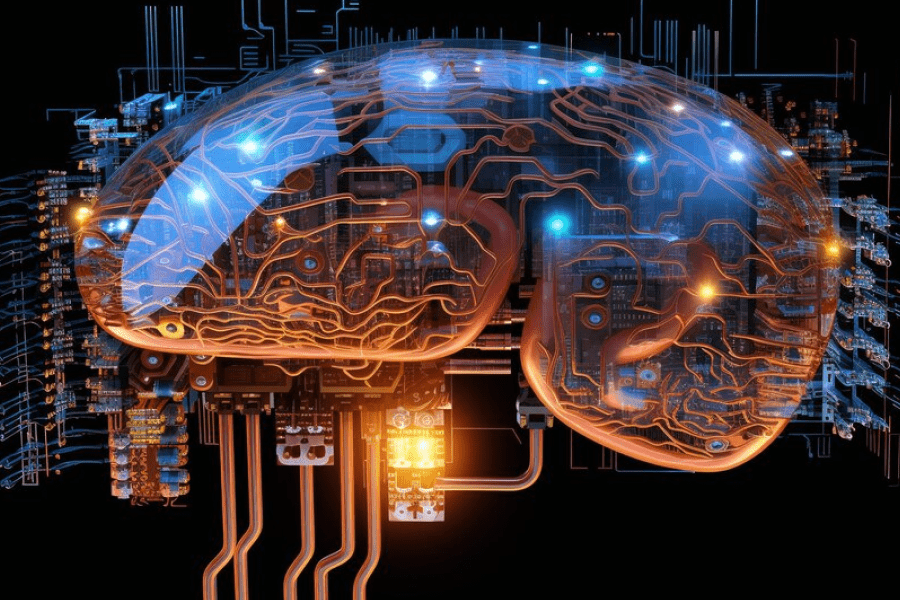AI-Powered Business Transformation
AI for your future. Automate, gain insights, transform.

In the realm of artificial intelligence, researchers have long been fascinated by the brain’s remarkable capabilities and efficiency. Neuromorphic computing has emerged as a promising field that aims to mimic the structure and functionality of the human brain in silicon. This technology holds tremendous potential for revolutionizing various domains, including robotics, machine learning, and cognitive computing.
Come let’s explore the concept of neuromorphic computing, its key components, and applications.
Neuromorphic computing refers to the design and development of computer systems that emulate the structure and function of biological neural networks. It draws inspiration from the human brain’s neural architecture, which consists of billions of interconnected neurons that communicate through synapses. The objective of neuromorphic computing is to create artificial neural networks that can efficiently process complex information in a massively parallel manner, similar to the brain’s cognitive abilities.
Neurons: In neuromorphic systems, artificial neurons are the fundamental building blocks. These neurons are designed to mimic the behavior of biological neurons, which process and transmit electrical signals. Artificial neurons receive input signals, perform computations using activation functions, and generate output signals.
Synapses: Synapses are the connections between neurons in the brain. They facilitate the transmission of electrical or chemical signals from one neuron to another. In neuromorphic computing, artificial synapses play a crucial role in connecting artificial neurons and enabling the flow of information. These synapses can be programmed to exhibit plasticity, allowing them to adapt and strengthen or weaken their connections based on learning experiences.
Spiking Neural Networks (SNNs): Unlike traditional artificial neural networks that operate using continuous values, SNNs are designed to operate on discrete spikes, mimicking the spiking behaviour of biological neurons. Spiking neural networks enable efficient event-based processing, resulting in low power consumption and high computational efficiency.
Robotics: Neuromorphic computing can significantly enhance robotic systems by enabling real-time perception, learning, and decision-making capabilities. Robots equipped with neuromorphic systems can adapt to dynamic environments, recognize objects, and interact with humans more intuitively.
Machine Learning: The parallel and distributed nature of neuromorphic computing makes it well-suited for machine learning tasks. Neuromorphic systems can accelerate the training and inference processes, leading to faster and more energy-efficient machine learning algorithms. They have the potential to revolutionize areas such as image and speech recognition, natural language processing, and pattern recognition.
Cognitive Computing: Neuromorphic computing can advance the field of cognitive computing by enabling systems to understand and respond to complex natural language queries, simulate human-like reasoning, and perform cognitive tasks. This has implications for areas such as virtual assistants, autonomous vehicles, and personalized medicine.
Despite its promise, neuromorphic computing still faces several challenges. Designing large-scale neuromorphic systems that are capable of processing vast amounts of data in real time remains a significant hurdle. Additionally, mapping complex neural network architectures onto hardware poses challenges in terms of power efficiency and scalability.
In the future, advancements in neuromorphic hardware and algorithms will likely address these challenges. Researchers are actively exploring novel materials, such as memristors, and developing efficient algorithms inspired by biological learning processes. These developments hold the potential to unlock the full power of neuromorphic computing and bring us closer to achieving human-level artificial intelligence.
Neuromorphic computing represents a fascinating approach to bridging the gap between biological and artificial intelligence. By emulating the brain’s neural architecture, these systems can unlock new possibilities in robotics, machine learning, and cognitive computing. While challenges remain, ongoing research and advancements in hardware and algorithms are paving the way for a future where neuromorphic computing plays a central role in creating more intelligent and capable machines. As we continue to unravel the mysteries of the brain, we inch closer to unlocking the full potential of neuromorphic computing and achieving a new era of artificial intelligence.
Need a tailored solution? Let us build it for you.
Connect Today